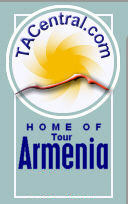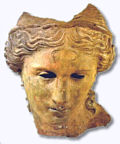 |
||||||||||||||||||||||||||||||
|
||||||||||||||||||||||||||||||
|
||||||||||||||||||||||||||||||
|
|||||||||||||||||||||||
|
|||||||||||||||||||||||
| - | |||||||||||||||||||||||
|
||
The first god in Armenia was one of the language’s first sounds, ‘AR’, which means sun or light. As the source of life, the sun became equated with power and the supreme god. Ararat is mentioned as early as ca. 6000 BC in the Sumerian epoch poem Gilgamesh, as the land of the mountains where the gods live. The word Ararat can be divided into three words: AR-AR-AT. AR-AR being a plural form or all encompassing god; ‘AT’ being an archaic version of the Armenian word ‘hat’, which means ‘a piece of’. Thus Ararat meant ‘a piece of gods, or a piece of creation. Early symbols for gods are closely connected with astral symbols. The first use of the sacred swastika and cross are found in ca. 20,000-15,000 BC inscriptions in the Geghama Mountain Range. Carvings dating back to ca. 8500 BCE show symbols associated with astronomy, giving them a god like prominence: the sun, moon, and constellations were thought to be deities in themselves, and astral occurrences such as an eclipse or a comet were considered communication from the gods. By the 5th millennium BC, Ancestral Armenians combined sun worship with sophisticated astronomy. They are now credited with assigning the constellations of the zodiac their design and names, and creating one of the first solar calendars based on 365 days in the year. Also around the 5th millennium BC a series of Vishaps (Dragon Stones) began to be erected on mountainsides throughout Armenia, near water sources. At first resembling fish (dragons in Armenian were thought to be huge fishlike creatures, something like a cross between a whale and a gigantic squid), the monolithic stones were later carved with snakes, the heads of beasts, swastikas and crosses. Around 3000 BC, Ancestral Armenians had created a specific iconography and pantheon of the gods. The Armenian gods were still centered on the worship of the sun, but by the Urartian period, they resembled Mesopotamian and Egyptian deities based on animal-human combinations. Human deities emerged during the Armenian Hellenistic period. Though bearing remarkable likeness to Greek gods and goddesses, which first gave speculation as to their Greek origins, it is now thought that many of the Greek gods are actually inherited from Ancestral Armenian sources, with some coming from as far away as India. The heroic legends of Hercules, for example, were first attributed to the legend of the Armenian king-god Haik in the 3rd millennium BC. Pantheon of Armenian gods Aramazd (Zeus) - The father of all gods and goddesses, the creator of heaven and earth. The first two letters in his name, "AR" is the Indo-European root for sun, light, and life. Aramazd was the source of earth’s fertility, making it fruitful and bountiful. The celebration in his honor was called Am'nor, or New Year, which was celebrated on March 21 in the old Armenian calendar (also the Spring equinox).Anahit (Artemis) - The goddess of fertility and birth, in early period she was the goddess of war. By the 1st c. BCE she was the main deity in Armenia.Nuneh (Athena) - The goddess of wisdom, common sense, motherhood and protector of the home, keeper of the family.Vahagan (Hephaestus) - The god of thunder, clouds and fire. Comes from "Vah" -god, "Agne" - fire. Vahagan is the constellation Orion.Astghik (Aphrodite) - The goddess of love and beauty, symbolized by skylight. She was the wife or lover of Vahagan, the god of fire and metal. She was also the goddess of water. The celebration in her honor occurred in mid June and was called Vardevar. It is still celebrated in Armenia by pouring water on unsuspecting passersby.Ara Geghetsik - "Ara the Beautiful’- the god of spring, flora, agriculture, sowing and water. He is associated with Isis, Vishnu and Dionysus, as the symbol of new life.Haik - a king, but in legend the father of Armenia. He slew the Babylonian god Bel, which in history was Nemruth, the Babylonian king described in the bible as attempting to build the tower of Babel. Haik’s armies invaded Babylon, and establish the kingdom from which Armenians claim their heritage. The legend of Haik is the forerunner of the legend of Hercules.Tsovinar, Nar - The goddess of water, sea, rain. She was a fire creature, who forced the rain and hail to fall from the heavens with her fury.Vanatur - the god of hospitality and bountiful hosts.Tir (Apollo) - the god of literature, science and art, also an interpreter of dreams.Tork Angegh (Aries) - the god of power, bravery, war, the military.Aralez - One of the oldest gods in the Armenian pantheon, Aralez was a god in the form of a dog, whose powers included the ability to resurrect the dead by licking wounds clean.
|
||
|
|
||
| |
Search | |
||||||


